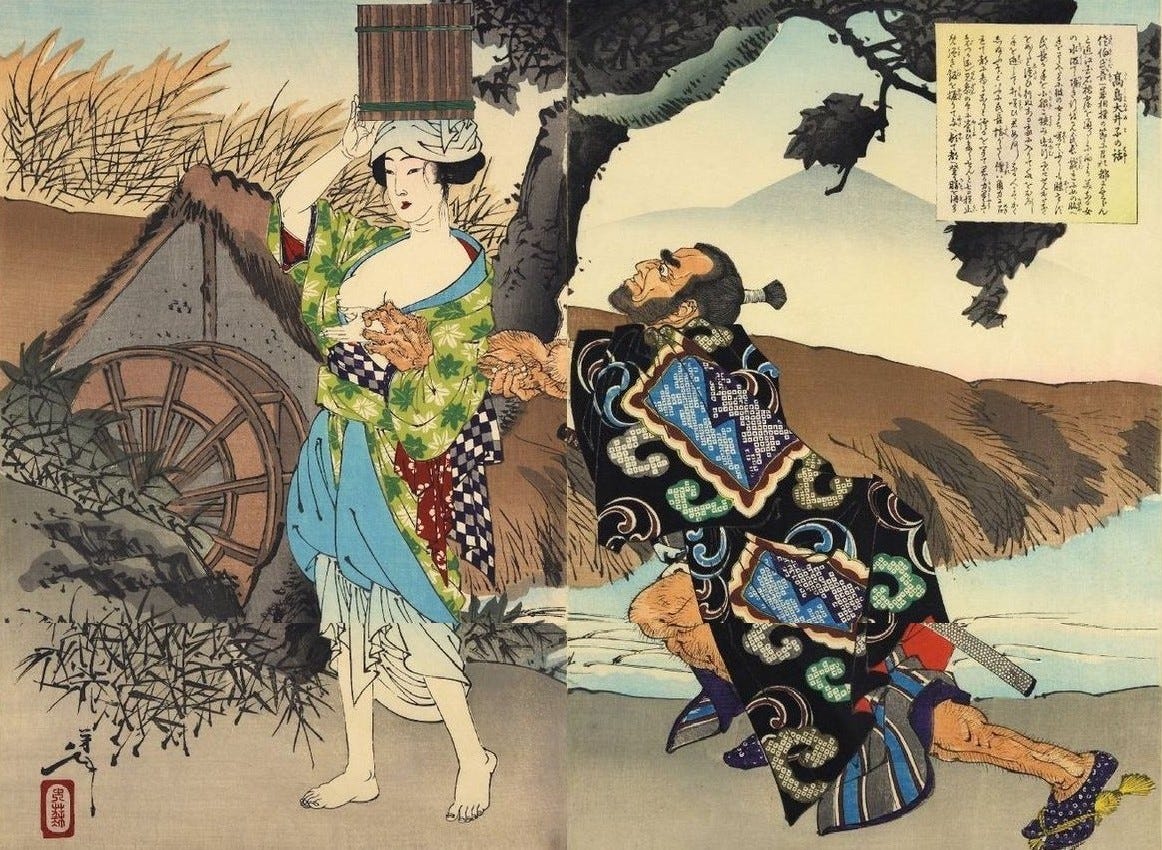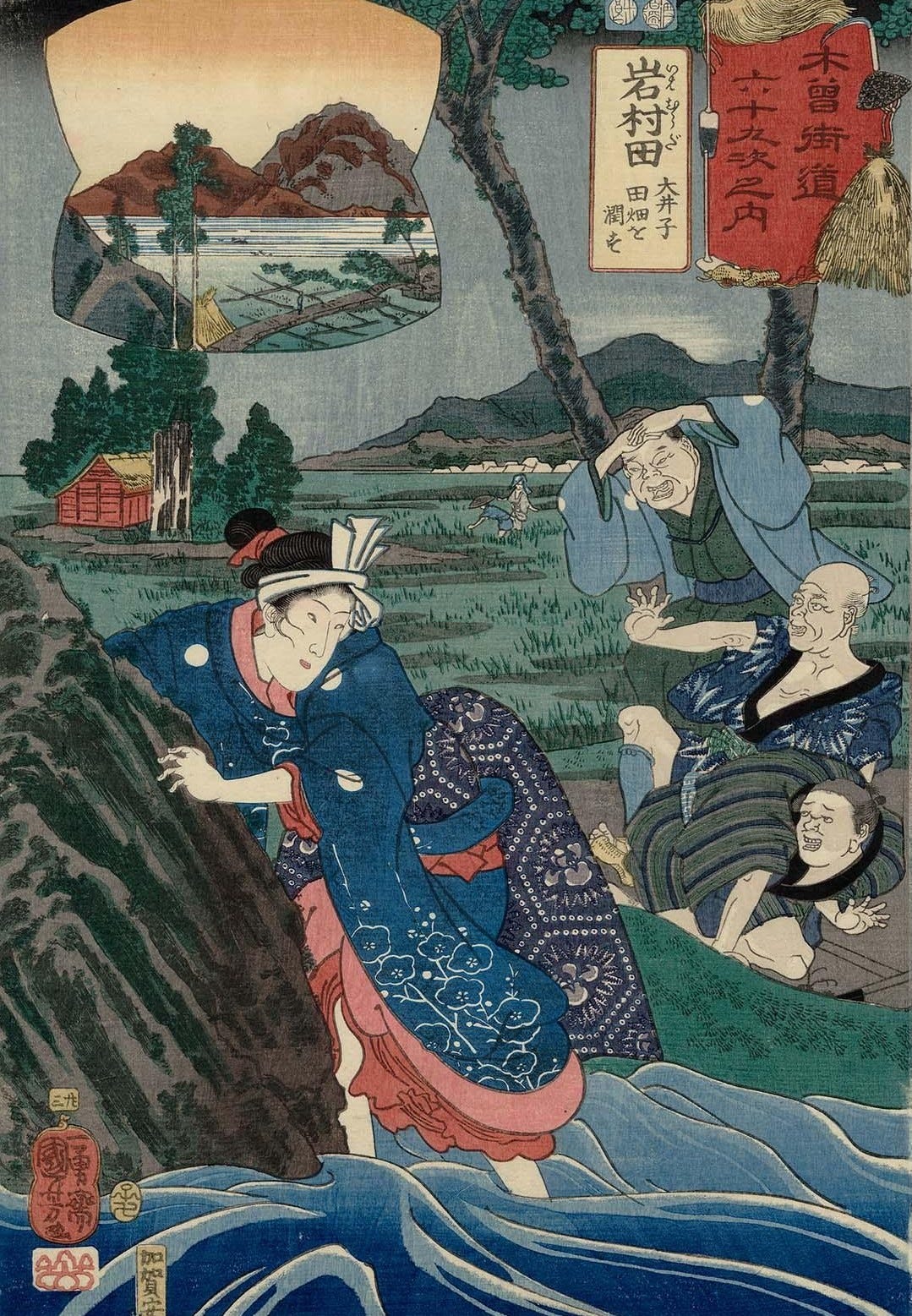Sumo Wrestler Tickles Strange Maiden, Makes Grave Mistake
Japanese Folktale

Setsuwa (説話, loosely translated ‘spoken stories’) are folktales, myths, and anecdotes that were first shared orally and eventually written down. Kokon Chomonjū (古今著聞集, “A Collection of Notable Tales Old and New”) is one of the most famous setsuwa collections. It was completed in 1254, but many of its stories are much older.
Ōiko Gets Tickled
Do you like strong women, sumo wrestling, and onigiri (rice balls)? Well, here’s a cool story from the Kokon Chomonjū about all three.
The wrestler Saeki Ujinaga (氏長 佐伯) was traveling from Echizen province to Kyoto to compete in a sumo tournament, dreaming of fame, fortune, and probably famous Kyoto courtesans. On his way, he saw a delightful young woman carrying a bucket of water on her head.
Recklessly assuming this was your average beautiful, bucket-carrying maiden, he introduced himself by trying to tickle her under her arm. Unfortunately for him, this was no ordinary bucket maiden. The woman laughed at his feeble attempts at sexual harassment and without letting go of her bucket or spilling a single drop, she squeezed her arm to her body like an organic clamp, trapping his hand. No matter how hard Ujinaga tried, he couldn't free his hand. Then the woman just walked home, carrying her bucket and one humbled sumo wrestler hanging from her arm like a kawaii phone charm.
Once home, they introduced themselves more properly. The woman was Takashima Ōiko (高島 大井子), a rice farmer. When Ujinaga admitted he was a wrestler on his way to a sumo tournament in the capital, Ōiko gently bruised his ego: "There are many strong wrestlers in the capital. You’re not a complete weakling, but you're not ready to face them. Perhaps you better stay here a while and let me train you."
Ujinaga realized Ōiko probably was right (and perhaps he was hoping for more tickling), so he stayed with her for three weeks. Every day Ōiko cooked rice for Ujinaga and packed it into onigiri, squeezing them tight.
The first day, Ujinaga was startled by the firmness of the rice, but he dutifully chewed through the onigiri. Ōiko, like a deranged fitness instructor sous-chef, increased the resistance of the rice each day without telling Ujinaga. After three weeks, he still marveled at the density and chewiness of the onigiri, but he had grown much stronger without even noticing, and his jawline probably looked amazing.
“You will have no trouble with the wrestlers in the capital now,” Ōiko said, and she sent him off. History does not record how his fortified chewing muscles helped him in the ring.
Ōiko Deals With Terrible Neighbors

Ōiko was too mighty to be contained by a single tale. There’s a second story about her in the Kokon Chomonjū, where she flexed her negotiation muscles. During a long drought, the farmers in Takashima argued about the distribution of water to their rice paddies. Some of the more foolish ones redirected water away from Ōiko’s rice paddy and into their own. Now Ōiko wasn’t the type to calmly file a formal complaint. She waited for nightfall. She picked up a rock larger than most Tokyo apartments and casually dropped it in the river, redirecting the water back to her paddy.
When morning came, the cheeky farmers got up to survey the results of their ill-gotten hydration, and found their fields dry. They soon discovered the boulder and lamented. They tried to move it, but a hundred people together budged the rock not an inch. When they begged Ōiko to please remove it she kindly agreed, and left it somewhere where it wouldn’t be in the way. Strangely, no one argued about water after that.
Which Version?
The version of the first story I used is from the Watson and Shirane book (see references below). It’s a bit different from the other versions I’ve seen, including this copy of the Kokon Chomonjū online. Watson and Shirane’s book doesn’t say they’ve changed the story so I’m not sure whether they used a different source or decided to change the story a bit.
In the more common version, poor Ujinaga at first cannot even bite into Ōiko’s onigiri because it seems to be hard as a rock. The second week, he is able to take a small bite. By the third week, he’s eating it like a champ.
I like the Watson and Shirane version because an onigiri so hard it can’t be eaten at all makes less sense to me, but who knows, maybe there are types of onigiri that are really hard to eat (especially if I try to make one). Also, these were originally oral stories so there could be many different variations.
Now Ōiko was just your average supernaturally strong woman, not a sumo wrestler. But there were actually official female sumo wrestlers in the past, with glorious names like Big Boobs and Holder of the Balls. Read about them here.
References
Dykstra, Yoshiko K. “Notable tales old and new: Tachibana Narisue’s Kokon Chomonjū,” Monumenta Nipponica, Vol. 47, No. 4 (Winter, 1992), pp. 469–493. http://www.jstor.org/stable/2385331
Mayer, Fanny Hagin (trans.) & Yanagita Kunio, “Yanagita Kunio: Japanese folk tales,” Folklore Studies, Vol. 11, No. 1, 1952, pp. i–97.
Watson, Burton (trans.), Shirane Haruo (ed.), The Demon at Agi Bridge and Other Japanese Tales. Columbia UP, 2011, pp. 126–128.
“The legend of Ōiko’s stone“ from https://liftingstones.org/articles/oikos-stone (retrieved 2025-07-25)

